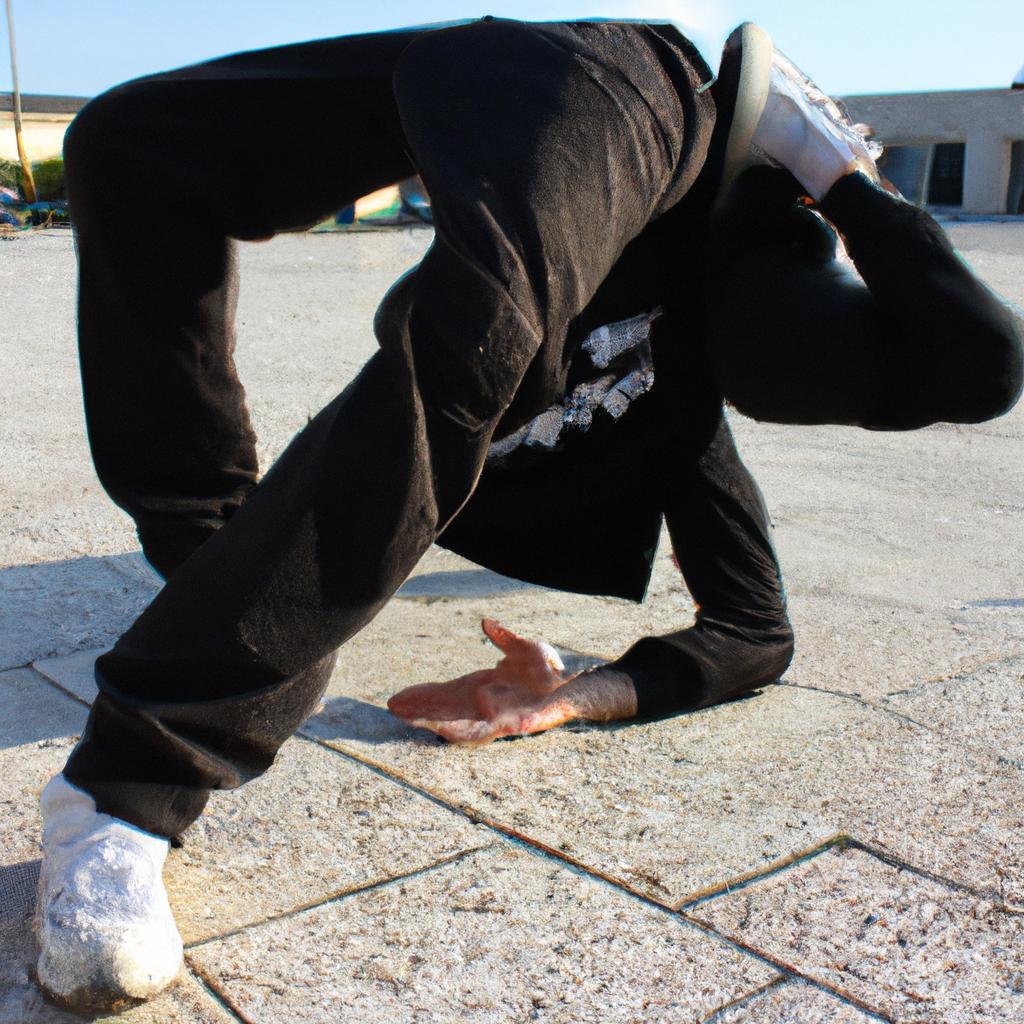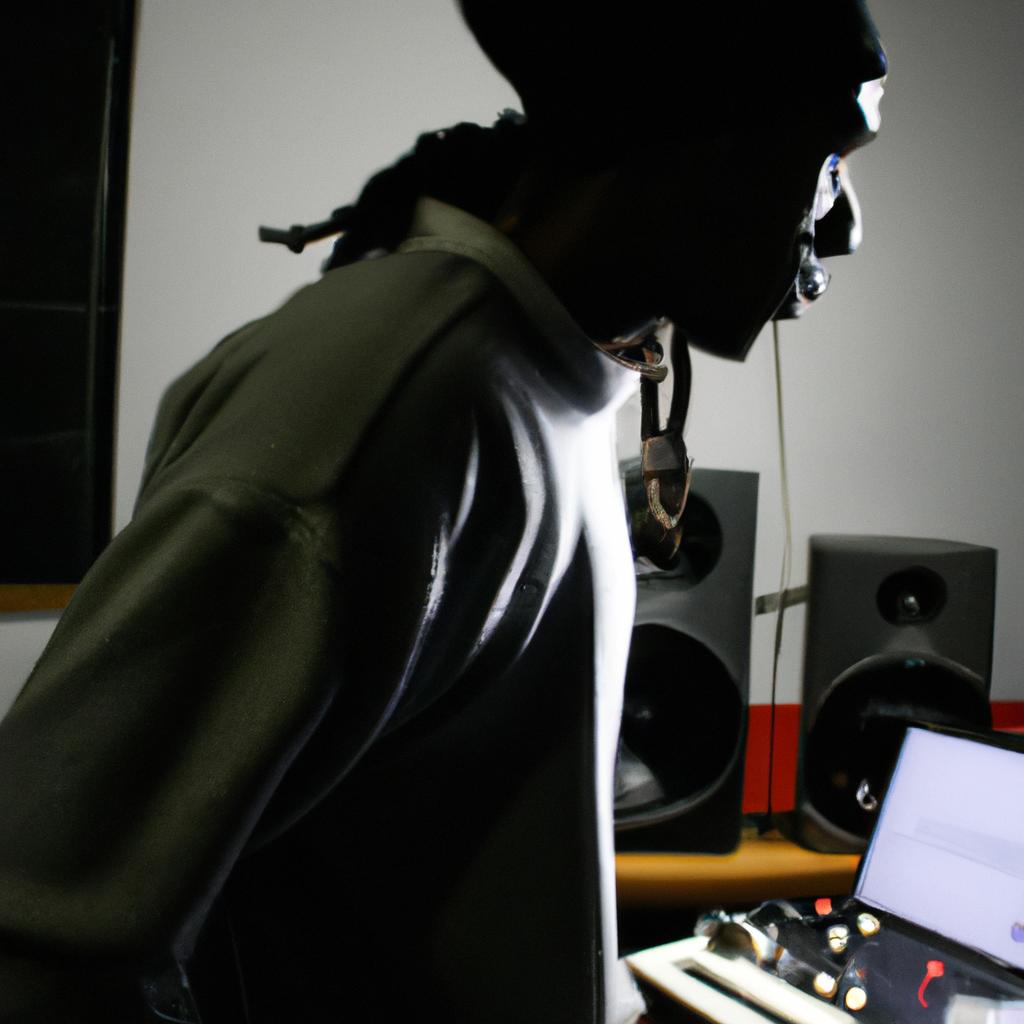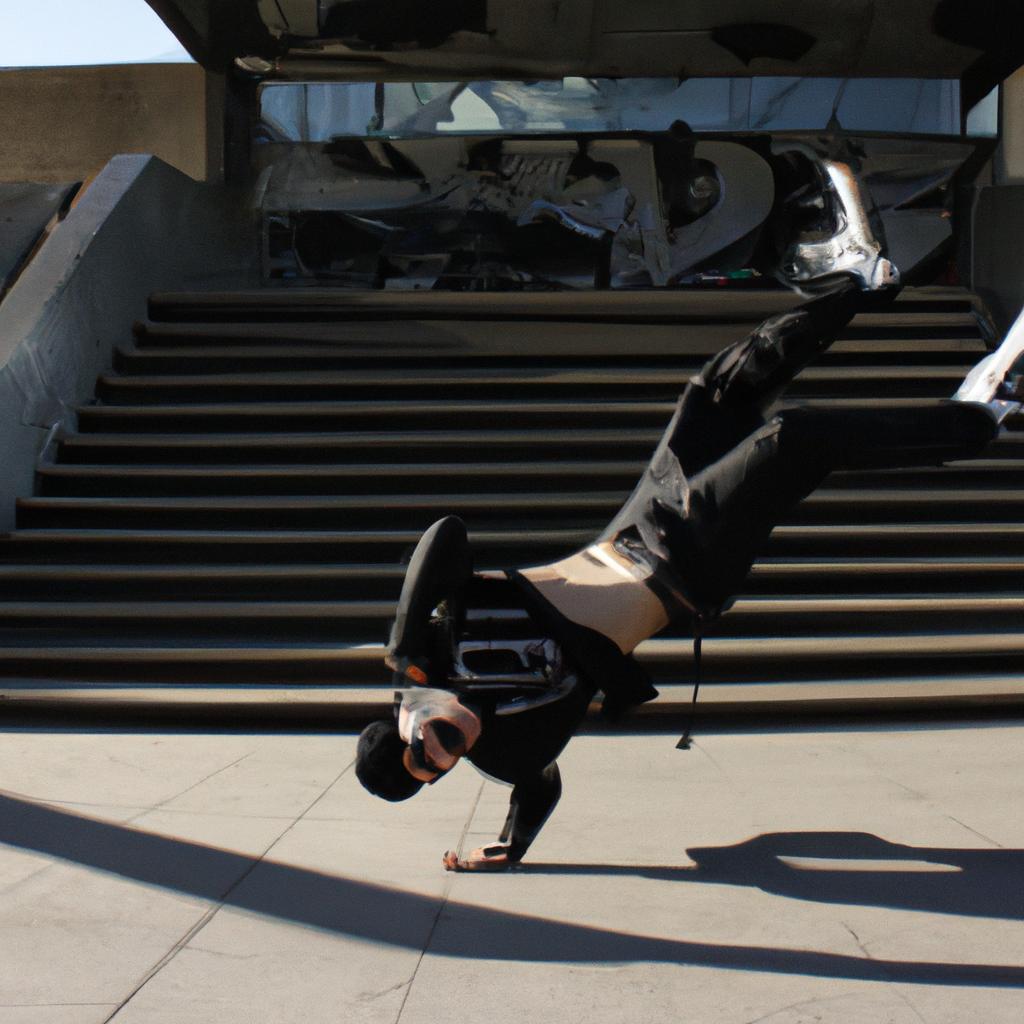Hip Hop dance has emerged as a powerful and influential art form that permeates the music industry. Through its dynamic movements, intricate choreography, and compelling storytelling, Hip Hop dance has shaped the artistic landscape of contemporary music. This article explores the artistic influence of Hip Hop dance in music by examining its impact on performers, audiences, and cultural expressions.
To illustrate this phenomenon, let us consider the case study of renowned artist Jay-Z. Throughout his illustrious career, Jay-Z has seamlessly integrated elements of Hip Hop dance into his performances to enhance the visual experience for his audience. By incorporating precise footwork, body isolations, and fluid gestures into his stage presence, Jay-Z’s performances transcend mere musicality. They become immersive experiences where movement becomes an extension of sound; each step amplifying the emotional depth conveyed through his lyrics.
Furthermore, beyond individual artists like Jay-Z, Hip Hop dance has contributed to shaping broader cultural expressions within the music industry. It serves as a platform for marginalized communities to express their identities and assert their agency in a society often resistant to their voices. The raw energy exuded through synchronized group routines or freestyle battles reflect both personal struggles and collective resilience. As such, these artistic expressions not only entertain but also challenge societal norms while simultaneously fostering a sense of unity and empowerment among its participants and audiences.
Additionally, the influence of Hip Hop dance extends beyond the stage and into music videos. Choreographed routines in music videos have become iconic visual representations of songs, often garnering millions of views and sparking viral dance challenges. These dances inspire fans to learn and recreate the moves, further spreading the influence and impact of Hip Hop dance within popular culture.
Moreover, Hip Hop dance has also influenced other genres of music, leading to collaborations between artists from different backgrounds. By incorporating elements such as breakdancing or popping into their performances, musicians from various genres infuse their work with an added layer of excitement and authenticity. This fusion not only broadens the artistic landscape but also deepens connections between diverse communities.
In conclusion, Hip Hop dance has established itself as a powerful force within the music industry. Its dynamic movements, intricate choreography, and compelling storytelling have transformed live performances into immersive experiences that transcend musical boundaries. Furthermore, it serves as a platform for self-expression and empowerment for marginalized communities while shaping cultural expressions within popular music. Through its influence on individual artists like Jay-Z, its presence in music videos, and its ability to bridge gaps between different genres, Hip Hop dance continues to shape the artistic landscape of contemporary music in profound ways.
Origins of Hip Hop Dance
Hip hop dance, a cultural phenomenon that emerged in the 1970s within African American and Latino communities in New York City, has left an indelible mark on the world of music and art. One example illustrating its impact is the rise of breakdancing crews like Rock Steady Crew from the Bronx, who popularized intricate moves such as headspins and windmills. This section will delve into the origins of hip hop dance, tracing its roots back to urban neighborhoods where it was born.
To understand the birth of hip hop dance, it is crucial to examine its historical context. In marginalized communities facing economic hardships and social inequality, young people sought creative outlets for self-expression. Drawing inspiration from various sources including African tribal dances, tap dancing, martial arts, and even gymnastics, they began fusing their movements together to create a unique style that would become synonymous with hip hop culture.
The emergence of hip hop dance can be attributed to several key factors:
- Street battles: Competitions known as “battles” became integral to the development of this dance form. Dancers engaged in friendly yet competitive showdowns to showcase their skills and gain respect among peers.
- Community spirit: The tight-knit nature of urban neighborhoods facilitated knowledge sharing among dancers. Individuals formed crews or groups where they could learn from one another and develop new moves collectively.
- Musical influence: Hip hop music provided the rhythmic foundation for these dances. As beats dropped and lyrics flowed through boomboxes on street corners, dancers were inspired by the energy and cadence of songs which influenced their choreography.
- Fashion statements: The distinctive fashion choices made by early practitioners further solidified hip hop’s identity. Baggy clothes allowed freedom of movement while sneakers with flat soles enabled dancers to glide effortlessly across surfaces.
| Street battles | Community spirit | Musical influence |
| Encouraged growth and innovation in hip hop dance. | Fostered a sense of camaraderie among dancers, leading to shared knowledge and collaborative creativity. | Provided the rhythmic foundation for choreography and inspired dancers with its energy and lyrics. |
The origins of hip hop dance are deeply rooted in the urban experiences of marginalized communities. It served as an outlet for self-expression, fostered a sense of community, and drew inspiration from various artistic influences. As we explore further, it becomes evident that this art form has evolved significantly over time, branching out into diverse styles while maintaining its core essence.
Transitioning seamlessly into the subsequent section about “Evolution of Hip Hop Dance Moves,” we can see how the early foundations laid during these origin years set the stage for continuous innovation and expansion within hip hop dance culture.
Evolution of Hip Hop Dance Moves
In the early 1970s, a new dance style emerged from the streets of New York City – hip hop dance. With its roots deeply embedded in African American and Latinx communities, this urban art form quickly gained popularity and became an integral part of the burgeoning hip hop culture. To understand the artistic influence that hip hop dance has had on music, it is essential to explore its origins and how it evolved over time.
One intriguing example of hip hop dance’s impact on music can be seen through the case study of breakdancing. Originating as a foundational element of hip hop culture, breakdancing revolutionized not only the way people moved but also how they interpreted music. Breakdancers would showcase their skills by performing intricate footwork, spins, freezes, and acrobatic moves to the beats of popular songs. This fusion between movement and rhythm created a symbiotic relationship between dancers and musicians, elevating both art forms to new heights.
The evolution of hip hop dance moves further solidified its artistic influence in music. As the genre diversified in terms of styles and subgenres, so did the range of movements within hip hop dance. From popping and locking to krumping and tutting, each unique style brought forth different emotions and narratives when set against various musical genres. This versatility allowed choreographers to create visually captivating performances that complemented or even challenged the lyrical content or mood conveyed in songs.
To evoke an emotional response in audiences regarding hip hop dance’s impact on music:
- It serves as a powerful tool for self-expression.
- It breaks down barriers by promoting inclusivity.
- It provides a platform for marginalized voices to be heard.
- It inspires creativity and innovation.
Table: Emotional Responses Evoked by Hip Hop Dance
| Emotion | Description |
|---|---|
| Empowerment | Feeling confident and strong |
| Joy | Experiencing happiness and elation |
| Unity | Feeling connected to a community |
| Liberation | Embracing freedom and self-expression |
In summary, hip hop dance emerged from humble origins and transformed into an influential art form that has left an indelible mark on the music industry. Its ability to fuse movement with rhythm, adapt to diverse musical genres, and evoke powerful emotional responses makes it a force to be reckoned with. As we delve deeper into the impact of hip hop dance on music videos, we will explore how this dynamic art form continues to shape and redefine visual storytelling in popular culture today.
Transitioning seamlessly into the subsequent section about “Impact of Hip Hop Dance on Music Videos,” we witness how this multidimensional art form extends beyond live performances onto our screens.
Impact of Hip Hop Dance on Music Videos
Now, let us delve into the fascinating evolution of hip hop dance moves and how they have influenced the music industry. One notable example is the emergence of breakdancing in the 1970s. This highly energetic form of street dancing captivated audiences with its acrobatic movements and intricate footwork.
The influence of hip hop dance on music videos cannot be overstated. Music artists recognized the power that dynamic choreography could bring to their visual storytelling. As a result, they began incorporating elements of hip hop dance into their music videos, creating a vibrant synergy between movement and sound.
To further illustrate this point, here are several key ways in which hip hop dance has made an impact on music videos:
- Increased Visual Appeal: By infusing music videos with hip hop dance routines, artists were able to create visually captivating experiences for viewers. The fluidity and athleticism displayed by dancers added excitement and flair to these productions.
- Enhanced Storytelling: Hip hop dance became a powerful tool for conveying narratives within music videos. Choreographed sequences helped convey emotions, themes, and messages in a way that words alone could not achieve.
- Cultural Representation: Through showcasing diverse styles within hip hop dance, music videos provided platforms for cultural expression and representation. Different forms such as popping, locking, or krumping allowed artists to celebrate various communities and foster inclusivity.
- Influence on Fashion: The aesthetics associated with hip hop dance often extended beyond just movement itself; it also influenced fashion trends portrayed in music videos. From baggy clothing to flashy accessories, these visuals served as reflections of urban culture’s unique style.
The table below highlights some iconic examples where hip hop dance greatly impacted the overall experience of selected music videos:
| Music Video | Artist | Notable Dance Move(s) |
|---|---|---|
| “Thriller” | Michael Jackson | Zombie Dance |
| “Single Ladies” | Beyoncé | Hand Gestures |
| “U Can’t Touch This” | MC Hammer | Running Man |
| “Gangnam Style” | Psy | Horse Riding Move |
As we can see, hip hop dance has played a significant role in shaping music videos into captivating visual spectacles. By infusing movement and choreography, artists have created an immersive experience that not only complements the music but also enhances its impact.
Moving forward, we will explore another dimension of hip hop dance’s influence: its role in expressing cultural identity. Through various movements and styles, this art form has become a powerful medium for individuals to convey their heritage and experiences without uttering a single word.
Role of Hip Hop Dance in Expressing Cultural Identity
The artistic influence of hip hop dance extends beyond the realm of music itself. In fact, it has had a significant impact on the production and aesthetics of music videos. One notable example is the iconic music video for Michael Jackson’s “Thriller,” released in 1983. Directed by John Landis, this groundbreaking piece not only showcased Jackson’s exceptional dancing skills but also incorporated elements of hip hop culture into its narrative and choreography.
Hip hop dance brought a fresh energy to music videos, revolutionizing the way artists expressed themselves visually. Here are some key ways in which hip hop dance has influenced the creation of music videos:
-
Dynamic Choreography: Hip hop dance introduced dynamic and intricate choreography that became an integral part of many memorable music videos. The fusion of different styles such as popping, locking, and breaking added a sense of excitement and visual appeal to these productions.
-
Street Aesthetics: With its origins rooted in street culture, hip hop dance brought a raw and authentic aesthetic to music videos. This authenticity resonated with audiences worldwide, as they could connect with the genuine expression and urban vibe portrayed through these visuals.
-
Cultural Representation: Hip hop dance provided a platform for diverse cultural representation within music videos. Artists began incorporating dancers from various backgrounds, showcasing their unique styles and celebrating diversity in both movement and appearance.
-
Visual Storytelling: Through innovative use of storytelling techniques in choreography, hip hop dance transformed music videos into captivating narratives. Dancers became characters who conveyed emotions and messages alongside the lyrics, enhancing the overall artistic experience for viewers.
This table illustrates how hip hop dance has influenced four famous music videos:
| Music Video | Artist | Release Year | Notable Hip Hop Dance Influence |
|---|---|---|---|
| “Formation” | Beyoncé | 2016 | Street dance styles, cultural representation |
| “Single Ladies” | Beyoncé | 2008 | Dynamic choreography, visual storytelling |
| “Uptown Funk” | Mark Ronson ft. Bruno Mars | 2014 | Fusion of funk and hip hop dance |
| “Bad Guy” | Billie Eilish | 2019 | Quirky movements inspired by hip hop |
The impact of hip hop dance on music videos has been far-reaching, influencing not only the visuals but also the overall creativity and innovation within the industry. As we move forward into exploring the role of hip hop dance in expressing cultural identity, it is important to acknowledge how its influence continues to shape artistic expressions across various forms of media.
The influence of hip hop dance extends beyond music videos; it has also played a significant role in shaping contemporary choreography.
Influence of Hip Hop Dance on Choreography
Role of Hip Hop Dance in Expressing Cultural Identity
Hip hop dance, with its intricate movements and dynamic energy, not only serves as a form of artistic expression but also plays a significant role in expressing cultural identity. Through the fusion of various dance styles and incorporation of personal narratives, hip hop dancers often convey powerful messages about their heritage, struggles, and triumphs. For instance, consider the case study of Kevin “KJ” Joseph, an Indian-American dancer based in New York City who seamlessly blends traditional Indian dances like Bharatanatyam with urban street dance forms.
One way in which hip hop dance expresses cultural identity is through the use of signposts such as costumes, gestures, and music choices. These signposts serve as visual cues that reflect specific characteristics associated with a particular culture or community. Take for example a group performance showcasing the diversity within hip hop culture:
- Costumes: Dancers wearing vibrant African prints alongside those adorned in traditional Asian garments.
- Gestures: Incorporation of hand signs symbolizing different cultures, such as bhangra-style hand movements or Afro-centric gestures inspired by West African traditions.
- Music Choices: Fusion of diverse musical genres from around the world – mixing beats from Latin America to Africa – creating a rich tapestry representative of global influences.
Moreover, hip hop dance has been influential in providing a platform for marginalized communities to express themselves authentically. This art form allows individuals to tell their stories and shed light on social issues affecting their respective communities. By incorporating themes such as racial inequality, gender discrimination, and socioeconomic disparities into their choreography, hip hop dancers challenge societal norms while sparking conversations and evoking emotions among audiences.
To further illustrate this point:
| Hip Hop Dance’s Influence on Culture |
|---|
| 1. Empowerment: It provides individuals with a means to reclaim their identities and challenge stereotypes. |
| 2. Unity: It fosters a sense of community and belonging, transcending geographical boundaries. |
| 3. Resilience: It showcases the strength and resilience of marginalized communities in the face of adversity. |
| 4. Evolution: It contributes to the continuous evolution of culture by embracing new influences and traditions. |
In conclusion, hip hop dance serves as an expressive outlet for individuals to celebrate their cultural heritage while addressing social issues. Through the use of signposts, incorporation of personal narratives, and its transformative power, hip hop dance allows artists to convey messages that resonate with diverse audiences worldwide.
Hip Hop Dance as a Form of Artistic Expression
Moving beyond its role in expressing cultural identity, hip hop dance also emerges as a powerful form of artistic expression that pushes boundaries and challenges traditional notions of dance aesthetics.
Hip Hop Dance as a Form of Artistic Expression
Building upon the previous section’s discussion on the influence of hip hop dance, this section will delve further into its impact on choreography. One notable example that highlights the transformative power of hip hop dance in shaping contemporary choreographic practices is the work of acclaimed dancer and choreographer Rennie Harris.
Rennie Harris, known for his innovative fusion of street dance styles with traditional modern dance techniques, has revolutionized the field through his incorporation of hip hop elements. His piece “Facing Mekka” showcases a seamless blend of diverse movement vocabularies, from popping and locking to breakdancing and krumping. By integrating these forms within a broader context, Harris challenges conventional notions of what constitutes legitimate artistic expression.
The influence of hip hop dance on choreography extends beyond individual artists like Rennie Harris. It has sparked a broader shift in how dancers and choreographers approach their craft. Here are some ways in which hip hop dance has influenced contemporary choreographic practices:
- Embracing authenticity: Hip hop’s emphasis on personal style and self-expression encourages dancers to embrace their unique voices rather than conforming to prescribed movements.
- Breaking down boundaries: Traditional divisions between genres such as ballet, jazz, and contemporary have become more fluid as hip hop infuses them with fresh energy and dynamism.
- Incorporating improvisation: The freestyle nature of many hip hop dances has led to an increased appreciation for improvised movement in choreography across different styles.
- Amplifying storytelling: Through powerful gestures and dynamic body language, hip hop dance brings narratives to life in ways that resonate deeply with audiences.
To illustrate these points visually, consider the following table showcasing key characteristics of traditional choreography versus those influenced by hip hop:
| Traditional Choreography | Hip Hop-Influenced Choreography |
|---|---|
| Formal structure | Freer form |
| Poised elegance | Raw energy |
| Rigid technique | Fluid movement |
| Narrative abstraction | Personal storytelling |
By incorporating elements of hip hop dance into their choreographic vocabulary, artists have been able to push boundaries and break free from traditional constraints. This evolution has not only enriched the art form but also created a space for diverse voices and narratives to be heard and celebrated.
In this section, we explored how hip hop dance has significantly influenced contemporary choreography by examining the work of Rennie Harris as an example. We discussed key ways in which hip hop’s influence manifests in choreographic practices, including embracing authenticity, breaking down genre boundaries, incorporating improvisation, and amplifying storytelling. Through these transformations, dancers and choreographers continue to redefine what it means to create truly innovative and expressive movement on stage.




